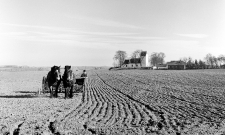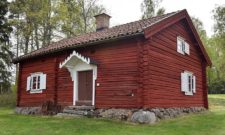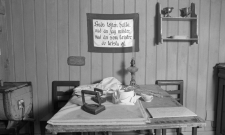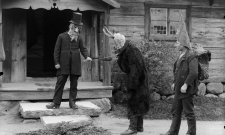Thoughts from the past, Texter
Gällersta ancient farm

Mar
Johan Lindström Saxon (1859-1935) writes about Gällersta ancient farm in the Swedish Tourist Association's yearbook 1930. To this day, thousands of Närking people gather at the ancient farm every year, not least at the annual Gällersta midsommarting. Sons and daughters of Närke are recommended to join Gällersta Forngårdsförening here.
Gällersta parish has become a cultural centre in Närke - not because of its central location but because a number of farmers and farm boys have created an institution there, about which Örebro läns hushållningssällskaps 1928 published Guide says: "Gällersta ancient farm in Attersta (12.4 km from Örebro), an open-air museum of high class, almost to be considered a Närkes Skansen, with several for the landscape characteristic, ancient buildings and valuable collecting grounds."
They started modestly with a cottage. Over time, it has grown to a 5 acre site with 16 buildings.
When the Gällersta Antiquities Society was founded, it was emphasized that the institution was by no means intended to be a museum only, but that the task at least as much meant to cherish the spiritual heritage the fathers and mothers gave in customs and traditions, in legend and history, in folk language and folk music, etc., but not least in the preservation of the local folk spirit.
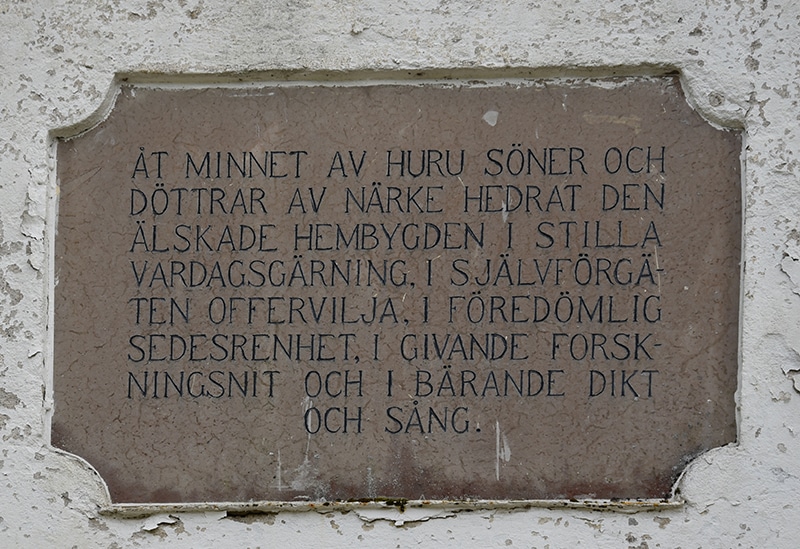
The ancient farm can be broadly divided into 3 groups: 1) the farmstead, 2) the general cultural section and 3) the crafts group.
There is a special access road to the farm. You enter the farm through a straw-covered gate, which has a one-storey cottage in the middle, the barn and stable with the gatehouse on the left, the lodge with its threshing floor and the cool room on the right. None of the old buildings are in the form of a museum. One imagines them inhabited. The householders have only gone out for the time being.

The cottage has - like all the older buildings of the ancient farm - a millstone for the first floor. This is where the province's foremost milling industry was located: 8 water mills in Attersta and 1 in Almbro, in addition to windmills at several farms.
Already at a glance into the front room we find what a trusted man father is; he is the village elder, and with him the village drum is kept. Here hang handcuffs and shackles: he is therefore also the quartermaster. Wolf spears and whale horns remind us of the battle against wolves that takes place every spring before the cattle are released to graze in the woods. Hunting and fishing tools - among the latter also lyres and crayfish hooks - testify to what the parish offered the fisherman and the hunter.
The cottage, i.e. the living room, is spacious. The limestone frame around the open fireplace bears the date 1769. In front of it stands the spinning wheel, a reminder of the kind of lighting in which the women used to make yarn. A chest - grandmother's maid's chest - dates from 1783, but the maid's cupboard, the chest's successor as the piece of furniture that the maid brought with her when she left for service, dates from 1826. The braided bed of forgiveness has the same date.
In the cradle there is steel, so that the trolls will not have power with the little one, and under his pillow a book has been placed, so that he will be "angry to read". In the window mother has a sewing basket and a pincushion, all showing that she is "needle patient" and what work she does while touching the cradle's mead. A devotional book testifies that she reads prayers to her son; and when he wakes he is amused with archaic toys.
We now go into the chamber, father's room. A filing cabinet with pasted-on postage stamps from the 18th century shows that literacy runs in the family. The table also has not only its stoneware inkwell with quill and sprinkler - indispensable before the invention of the reading paper - but also a wax stack. The books on the table - the "Little Guide" and agricultural literature - are evidence of what father does in his everyday life.
The kitchen has a shelf, cupboards, a table and a "reversible chair", which becomes a table when it is turned over. Among the household utensils, a limestone butter dish is particularly noteworthy, a material in which Närke has such an abundant supply. Copper vessels are numerous - Gällersta has had copper smiths since the 18th century.
The cool room is on two floors. To the left of the lower compartment is the storehouse with grain and milk racks of hollowed wood, drinking barrel, butter core, candle mould and sticks, malting tin, malt mill, etc. The greatest peculiarity here is the "pork roof": over the hooks for pork, sausages, etc., made of wooden branches, one half of a hollowed log has been placed to prevent the rats accessing the sleeping quarters.
The right-hand room at the upper bottom is the "maid's room", i.e. the girls' room. A sewing table with a sewing box and a piece of embroidery in progress stands by the beautiful stained glass window. Other needlework includes a pair of artistically embroidered trouser suspenders (a groom's gift), a bridal garter (which prevented snake venom from spreading beyond the knot, relieved childhood bed sores, etc.), a turban and white embroidery. Such things were made for the ladies of the manor, but even peasant girls were taught them to earn money from them. This was especially the case in Gällersta, where there used to be a lot of manors. Now all the farms of the parish are in peasant hands. Incidentally, this mixture of manorial and commonplace objects, which is characteristic of Gällersta parish, can be found everywhere in the collections of the old farm - and, since ancient times, even in the language of the parishioners. It is common, that the word order is the national language, but the vocabulary purely local.
On the wall hangs a hymn icon with a hymn book in hymn writing. A portrait of Prince Gustaf and a painting depicting the prince on his deathbed recall the popularity he enjoyed as a landowner in Närke, especially among the youth, who travelled long distances to attend the public festivals he organised on his estate, Stjärnsund.
To the left of the upper floor is the night room, the farm's guest room when needed, used in everyday life as a weaving chamber, as the complete collection of weaving tools makes clear.
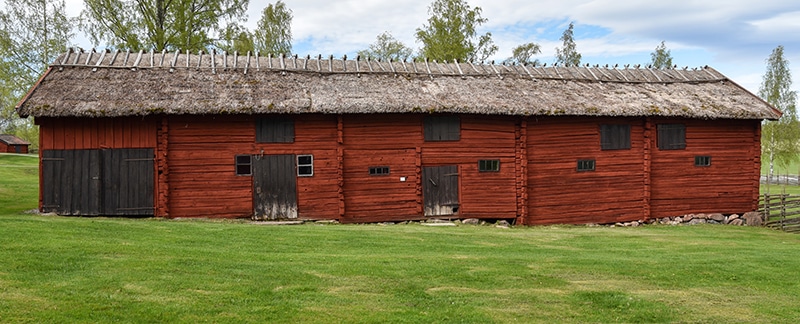
The lodge has threshing machines, but also beaters, grain harps and more primitive grain-cleaning tools, such as the vanna and the throwing shovel. The barn row begins at the top with the gatehouse, containing, among other things, a couple of good examples of old wagons. The barn's array of harnesses dates back to the blue and red painted ones. The bed is for the boy, who slept in the stable; his is also the corner cupboard. The barn is called "fäguse" (fähuset) in local dialect.
If we continue uphill, we come to the library courtyard and the second group of ancient farm buildings.
We cannot fail to glance in passing at the beautiful gable end of the balcony with the slope shaded by birch trees. And so we continue uphill.
The centrepiece of the library courtyard is the Närke Stone, a 3 ½ metre high building stone placed on a hill, which, under the heading "Sons and daughters of Närke", records some 80 names of remarkable Närke people and their families. The stone is an important part of the ancient farm's activities. A reminder of the achievements of Närke's most important sons and daughters is intended as an incentive to good work.
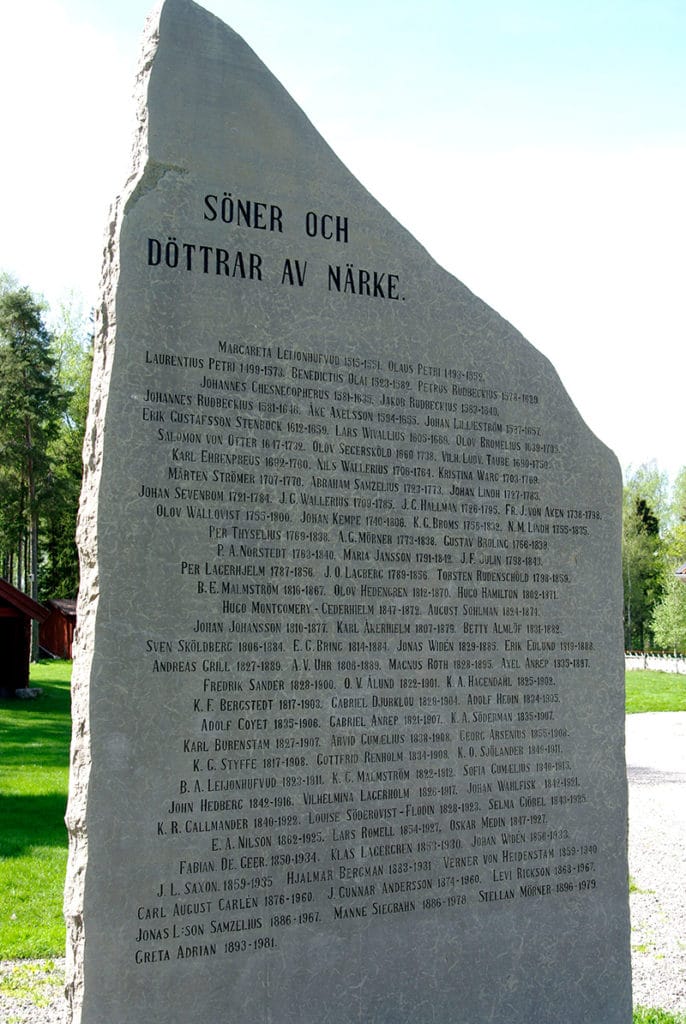
On the left in the library courtyard we have the library. It was built to house a collection of Närke literature, plates, maps, portraits, autographs, manuscripts, etc., donated by individuals, the largest in existence and with many rarities, which the Royal Library and the university libraries lack.

Next to the library is the soldiers' hut, in the front room of which we find several uniform insignia. The meetings at Sannahed were short and the soldier must therefore have had a civilian profession besides the military. He was a shoemaker. The shoe-desk in the living room, the lasts (for leather galoshes, among other things), the blocks, etc. constitute a complete set of shoemaking tools. For repair are submitted "German" boots (horse leather) for a little boy, shoes with a damaged nose, etc.
The soldier is also skilled in the art of medicine; a neat little cupboard on the wall holds his instruments: a home-made hook for pulling teeth, vein clippers for humans and animals, and so on.
The hut houses several wartime attributes: rifles and canteens of various designs, a saluting cannon and a sharpshooter's uniform - the soldier takes care of saluting at weddings etc. and is an instructor for the parish sharpshooter's corps. The paintings on the walls recall his warrior profession and his patriotic spirit. On the folding table is not only a Bible but also an instruction for officers and non-commissioned officers, indicating that the soldier speculates on becoming a sergeant and in due course a sergeant major.
Behind the Närkes stone are the music room, the mortar, the last of the parish, with all the tools needed for flax preparation, and the tool house, containing a rich collection of agricultural tools, including the plough with which a large part of the meadows made available for cultivation by the Kvisma subsidence were ploughed. The forest pavilion is also located here, illustrating the past and present of forestry in Närke, which is so rich in forests.

To the right we have the gable of the Gillestugan and the long side of its wing building, S:t Olofssalen. Gillestugan contains a meeting hall with a grandstand, seating 35O people. S:t Olofssalen has its main entrance from the library courtyard. The Närke coat of arms is enthroned above the high bench in this hall. A seated St. Olof is painted on the top of the open fireplace. The original - a sculpture - belongs to Sköllersta Church. The pulpit, which is from Ökna village in Gällersta parish, has this inscription:
God who is our life,
guard thetta house and farm
and therefore have vague and care.
Anno 1638. Olof Olsson.
The third group of buildings can be called the craft group. These include the nubb smithy, the copper smithy and the windmill.

The windmill was the last one in Närke to be used for milling with wind power. It originates from Körtingsberg in Viby. The nubb smithy is from Lerbäck, but the copper smithy was built in Gällersta (Attersta), and it has long been used for the craft, which, as mentioned, dates back to the 18th century in the parish.
Every year a public festival is held at the ancient farm, which is intended solely to illustrate the purpose of the ancient farm. Whether it is a Viking procession, an old-fashioned farmer's wedding or a harvest guild, or dramatic performances, etc., lectures are held illustrating the history of the province and - not least - the deceased or living local personalities, to whom the province has reason to look up to, whether their work consisted in "breaking up tents or cultivating souls". And usually there is an exhibition to highlight the work of a local, such as the paintings of Axel Borg, what Professor J. G. Andersson saw in China or the poetry of Verner von Heidenstam.
These parties are held partly in the library courtyard, partly below the Gillestugan, where a terrace has been built for the purpose. The ancient farm's folk dance troupe performs there. There the old folk games and folk dances are revived, which the dance floors are killing off. Cheerful stories are told in the local language. There is colour all over the board, for at least 50 Gällerstabor are dressed in their colourful folk costume, which as far as the women are concerned has become the parish's festive and holiday costume. They weave and sew it themselves. And bright braids hang down over the dress with the beautiful striping.
This is the general festival of the province. Every year on a July or August Sunday, 6-10,000 people gather here. People of all walks of life, all ages and all political persuasions come together in the feeling that, in this time of division, they have one thing in common: love of their homeland.
Subscribe to YouTube:
If you appreciate Allmogens independent work to portray our fine Swedish history and Nordic culture, you are welcome to buy something nice in the shop or support us with a voluntary donation. Thank you in advance!
Support Allmogens via Swish: 123 258 97 29
Support Allmogens by becoming a member
Support Allmogens in your will
Historical maps of Närke
Our wall maps are carefully restored, centuries-old maps that are reprinted in Ångermanland on matte, age-resistant, museum-quality premium paper. 1% of the proceeds go directly back to cultural heritage!


